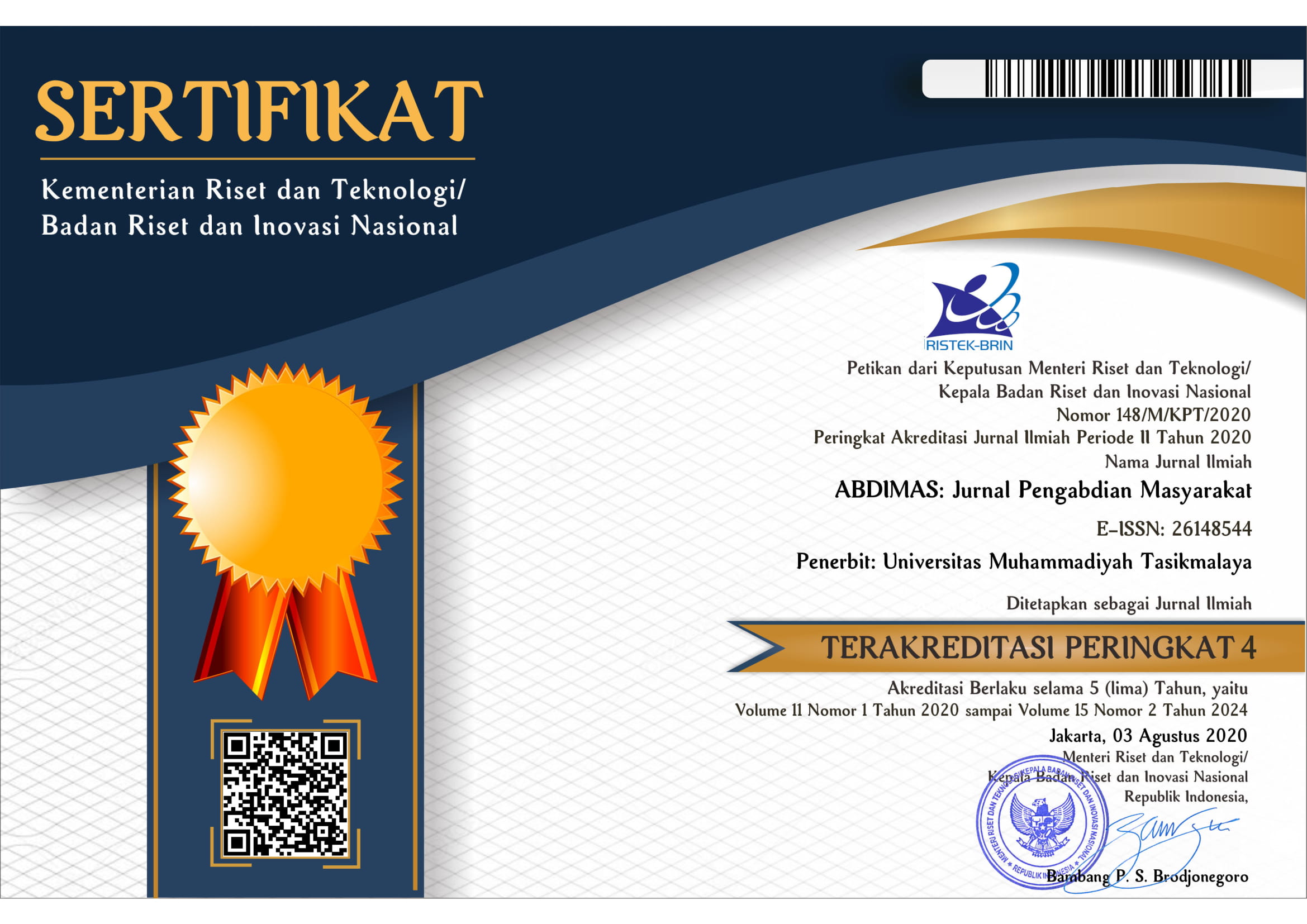Community Service for Grade IV Elementary Schools by Implementing Healthy Snacks at Cipunagara Public Elementary School
DOI:
https://doi.org/10.35568/abdimas.v6i2.3109Abstract
Snack food is food and drink that is processed by food artisans at the point of sale and or served as ready-to-eat food for sale to the public other than those served by catering services, restaurants or restaurants and hotels. Government (PP) No. 19 of 2005 concerning National Education Standards (SNP) that every education unit is required to have facilities and infrastructure, including a canteen or school canteen. Based on the results of the BPOM survey, it shows that 99% of school children buy snacks at school. Healthy and nutritious snacks are very important in playing a role in providing energy and nutrition for children, especially school age. Along with the times, more and more chemicals have been developed and used as additives in snacks and food. Poisoning cases in Indonesia from 2004 until now are still a polemic from the mass media, electronic media. are poisoning due to snack food and processed food poisoning. The purpose of the research is to socialize in increasing knowledge and changing the behavior of female students so they understand healthy snacks. The method used in this research is descriptive research method. This activity is carried out in the form of counseling by displaying material in the form of power points, posters, videos. The sample is 25 class IV students and students. Data collection techniques were carried out by interviews, observation, and documentation. The results show that 60% of students with a lack of knowledge still eat snacks carelessly at school without sorting out healthy or unhealthy foods, for example, snack drinks that contain striking dyes, fried foods that come from black oil. 20% snacks at school and supplies at home, 10% of students don't snack carelessly.
Downloads
References
Adriani Merryana, & Bambang wiratmadji. (2014). Gizi dan Kesehatan Balita, Peranan Mikro Zinc pada Pertumbuhan Balita. Kharisma Putra Utama.
Biswan, M., Puspita, E., & Jurusan Kebidanan Poltekkes Kemenkes Jakarta, D. I. (2018). Pola Asuh Ibu dan Status Gizi Balita. Quality Jurnal Kesehatan, 9(1), 1–41.
Depkes RI. (2018). Kementerian Kesehatan Republik Indonesia. Kementerian Kesehatan RI.
Gusrianti, G., Azkha, N., & Bachtiar, H. (2020). Analisis Faktor yang Berhubungan dengan Status Gizi Balita di Kelurahan Limau Manis Selatan Wilayah Kerja Puskesmas Pauh Kota Padang. Jurnal Kesehatan Andalas, 8(4), 109–114. https://doi.org/10.25077/jka.v8i4.1126
Juaeriah, R., & Susanti, D. (2015). Implementation of Mother Toddler Classes in Improving Mothers ’ Attitudes about Toddler Health through Interprofessional Education at Leuwigajah Public Health Center Area.
Kadir, Y., Ismail, N., Moonty, R. M., Nurmala, L. D., & Aldiyanto, A. (2022). Socialization and Education of The Impact of Free Association on High School Students of Posigadan Village Milangodaa District Tomini , District South Bolaang Mongondow , North Sulawesi Province. 2–4.
Kemenkes RI. (2018). Buletin Stunting. In Kementerian Kesehatan RI (Vol. 301, Issue 5, pp. 1163–1178).
Kementerian Kesehatan RI Jakarta. (2019). Pedoman Pencegahan dan Tatalaksana Gizi Buruk pada Balita. Kementerian Kesehatan RI.
Kementrian Kesehatan RI. (2018). Cegah Stunting, itu Penting. Pusat Data Dan Informasi, Kementerian Kesehatan RI, 1–27.
Rachman, Ika, A. (2016). Gambaran Asupan Makanan, Status Gizi, dan Prestasi Belajar Murid Sd Negeri No 18 Pulau Burung Loe II Kecamatan Pulau-Pulau IX Kabupaten Sinjai. 18, 1–112. http://repositori.uin-alauddin.ac.id/4053/
Rahmini Shabaria, T. C. P. (2020). Hubungan antara Asupan zat gizi dengan status gizi pada balita di TK Pelita Pertiwi Cicurug Sukabumi. Muhammadiyah Journal of Nutrition and Food Science.
Ruwayda, R., Nopiska Lilis, D., & Izhar, M. D. (2022). Establishment of A Reproductive Health Care Carader in Integrated Service Post (Posyandu) Youth Village Penyengat Olak Muaro Jambi District. ABDIMAS: Jurnal Pengabdian Masyarakat, 4(2), 697–702. https://doi.org/10.35568/abdimas.v4i2.1199
Sari, Y. D., & Rachmawati, R. (2020). Kontribusi Zat Gizi Makanan Jajanan Terhadap Asupan Energi Sehari Di Indonesia (Analisis Data Survey Konsumsi Makanan Individu 2014) [Food Away From Home (Fafh) Contribution of Nutrition To Daily Total Energy Intake in Indonesia]. Penelitian Gizi Dan Makanan (The Journal of Nutrition and Food Research), 43(1), 29–40. https://doi.org/10.22435/pgm.v43i1.2891
Tasikmalaya, L. M., Yulianti, M., Afriani, D., & Nurfauziatul, P. (n.d.). Abdimas Umtas : Jurnal Pengabdian Kepada Masyarakat Increasing Public Knowledge about Stunting and Complementary Foods as an Effort to Prevent Stunting in Tanjungwangi Village Tanjungmedar District.














